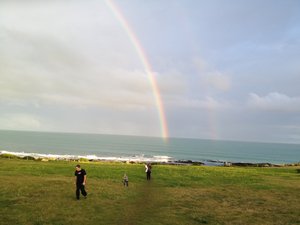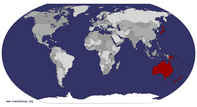Advertisement
Published: August 3rd 2017

 whale watching at Middleton
whale watching at Middleton
The small black dots are the whales!Some of my friends wondered why I would drive for two days to our destination and then return again, a total of four days driving (approximately 2,200 kilometres) – just to have two days to watch whales in the national park in the centre of Australia. I could alternatively drive only an hour south of Adelaide and see whales.
I hope the words and pictures that follow explain this. Or you could just think I’m crazy!?
I have spent many hours watching whales from shore at Basham’s Beach near Middleton just south of Adelaide. It has given me great joy to see these huge animals seemingly floating around in the ‘shallows’ of the ocean mostly in groups of two – mother and baby.
It has mainly been in July when the weather is cold for us (15 degrees Celsius at the most) grey skies and windy often on days when shower squalls occur and drop rain for 20-30 minutes – enough rain to soak you unless you are prepared - on and off all day, or else there is a light drizzle through out the day.
It is often
with numbers of other whale watchers, locals, holidaymakers and those who come down from Adelaide to observe the whales for the day, and more recently, busloads of people who want to see Southern Right Whales while visiting our country.
Although most people are quiet in their observations all the noises of the surrounding townships - cars and buses parking and leaving, bike riders and surfers going about their business, dogs being walked on the beach and the odd fisherperson - all add white noise to the wind and wave noise. In addition there are boats on the water. Pleasure craft – people who enjoy driving motorboats on the ocean to fish, enjoy the view - ply the water in small numbers adding white blobs to the greyish ocean. Whaleboats with 30 or more avid whale watchers sit the regulation 300 metres away from the whales. Fortunately there are only two or three unlike in some other countries where I have been lucky enough to see whales where there can be up to a dozen boats surrounding the whales! Add surfers, surf kites and beachcombers and there are many activities going on around the whales. Every one respects
the whales but it is a busy and expectant environment.
Australia has protected Southern Right Whales since 1935. Here are some whale facts provided by the NSW National Parks website who provide an excellent photo of this type of whale:
• Length Adults: 14m to 18m; Calves: 5m to 6m at birth
• Weight Adults: up to 80 tonnes; Calves: 1 to 1.5 tonnes at birth
• Gestation: 11 to 12 months• Weaning age: 11 to 12 months
• Calving interval: generally 3 years• Physical maturity age: unknown; Length: 16m
• Sexual maturity age: 9 to 10 years
• Mating season: July to August• Calving season: June to August
• Cruising speed: 3km/h
• Blow pattern: V-shaped bushy blow, up to 5m
Another fact we found out from the local ranger is that each day the baby adds 60 kgs to its body weight by drinking its mother’s milk. The mother doesn’t get to eat while she is in our waters from June to October calving or caring for her calf. She takes it back to the Antarctic so they can both eat krill

 Signs on entering the Nullabor Plain
Signs on entering the Nullabor Plain
We saw non of these animals but it was daylight when we drove!all summer.
As we drove out of the city we noticed how ‘big’ the sky is – how we can see the horizon, watch the sunset over few buildings and see vast distances of land and sky. The further we drove the more wonderous it seemed.
We drove through Yalata, which is Aboriginal Land, to get to the Nullabor national park. There the land is not farmed so we drove through natural bush for many kilometres and could enjoy native Australian plants bushes and trees growing. The colours are to me so Australian. No grass green or European tree colours, shapes or textures. Here the understorey, or ground layer, was yellows pinks and greys mainly salt bushes, with trees with white and dark grey trunks, familiar scraggly shapes with nests of branches and leaves forming a distinctive layers of wattles and eucalypts, unlike the straight up and down of pines or oaks. Their predominant colour was a far more yellowish green than the crops we had passed that were closer to new vegetables or grass.
Then onto the Nullabor Plain.
The sign calls the plain treeless. This is

 Nullabor landscape
Nullabor landscape
Capturing the size, beauty and vastness of the plain is something my camera and I have trouble doing.because there is no vegetation higher than your ankles. The vastness of the landscape is breathtaking and amazingly beautiful. There is only grey and pinkish brown low vegetation and blue sky!
To understand how big it is here is what Wikipedia has to say:
The Nullarbor Plain (
/ˈnʌlərbɔːr/ NUL-ər-bor;
Latin: nullus, "no", and arbor, "tree") is part of the area of flat, almost treeless,
arid or semi-arid country of southern Australia, located on the
Great Australian Bight coast with the
Great Victoria Desert to its north. It is the world's largest single exposure of
limestone bedrock, and occupies an area of about 200,000 square kilometres(77,000 sq mi). At its widest point, it stretches about 1,100 kilometres(684 mi) from east to west across the border between
South Australia and
Western Australia.
We were there in the late afternoon; we could enjoy it for the best part of 30 minutes in the car before we got to the Nullabor Roadhouse.
For those unfamiliar with a ‘roadhouse’ it is a tiny cluster of buildings just by the highway where you can buy petrol, food, stay in a hotel room, or caravan park. This one had a small airstrip to

 Nullabor Raodhouse
Nullabor Raodhouse
A tiny settlement in the central south of Australiaenable scenic flights over the whales. The permanent population is comprised those who work at the roadhouse only.
Day one we headed for the Head of the Bight ranger station, paid the entry fee and walked 200 metres to the cliffs then halfway down the face of the cliff on a purpose build ramp and there they were: five pairs of mother/baby whales just below us in the ocean!
The national park created two large ramps that allowed us to walk from the top of the cliffs half way down the front of the cliffs. This gave us a feeling of hanging in mid air above the whales. Something you can't do from the shore when you are parallel to the ocean surface.
We could hear the noise when the whales blew; we could tell if it was a baby or a mother from the volume. Occasionally we could hear a groan from the mother. We could see the white patches on the whales. They were just floating about doing mummy and baby business immediately below us. Hearing the blow noises is most unusual from the beaches near Adelaide.

 15 minutes before sunset
15 minutes before sunset
it was freezing - strong cold wind - I went inside to watch the end of the magnificent sunset.We were lucky with the weather. The sky was cloudless blue, the ocean calm, a deeper blue with clear water.
People came and went around us, very few stayed longer than 30 minutes. They were travelling across the continent, whale watching a moment in a bigger adventure. There were no boats or any mechanical devices, we could see no built structures beside the ramp we stood on. The only noises besides thosewe made was the wind and the whales because we were in a national park whose sole purpose was to conserve the land and marine environment to protect the whales. There was nothing between Antarctica and us but the ocean.
We had rest stops from the sun and the wind at the ranger station/shop for morning tea and late lunch but spent our whole day marvelling at the whales.
About four o’clock the close in whales seemed to parade by us in pairs, the babies frolicking and trying to breach or jump up out of the water and further out we could see tail flukes and splashes. The day just whizzed by, our 8 hour day seemed like 90

 20 minutes after sunrise
20 minutes after sunrise
It was still freezing but I couldnt' resist the glorious start to our morning!minutes.
Day two we arrived when the ranger station opened. We stopped at the top of the ramp in awe. The ocean was calm. There were tens of V shaped white plumes in the ocean. As though there were chimneys sending up white smoke signals all across the huge bay. The vapour of the blows didn’t remain for longer than a few seconds. So it was a very ephemeral vista.
We were amazed and just stood speechless for about half an hour. Unfortunately, none of our cameras could capture the panorama. Then the light changed, the mist on the far shore evaporated and we could only see the evidence of whales nearby when they blew. We just had to watch the whales close to the cliffs from our ramps knowing there could be as many as 40 whales nearby but only about 10 that our eyes could pick up on the surface of the ocean. Watching whales for another morning did not bore me!
We decided to drive 9 kilometres inland to find some caves that have cultural significance to the local Aboriginal people. The Karst limestone of the Nullabor plain

 Entry ticeket to the natonal park
Entry ticeket to the natonal park
It shows and aerial view of the ranger station, and the ramps down the face of the cliffs for whale viewing. means that there are many caves. The caves were once the homes of the traditional people as they moved about their country.
It was a great contrast to sit on the ground and only see the sky and the low grey/ blue vegetation as far as we could see. It topped up my soul in a different way to whale watching in the national park.
The wind came up in the afternoon so the swell of the waves and their white caps were visible. It didn’t appear to disturb the whales and they entertained us with another passing parade of mothers and frolicking babies. We got to see a rare white whale calf. They are not albino. They grow into black or grey whales.
We were the last to leave delighted to have taken the opportunity to spend time with whales in their magnificent national park.
Advertisement
Tot: 0.203s; Tpl: 0.044s; cc: 11; qc: 46; dbt: 0.0466s; 1; m:domysql w:travelblog (10.17.0.13); sld: 1;
; mem: 1.1mb





















